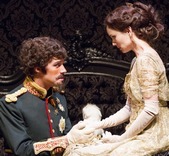SITE GUIDE
SEARCH
REVIEWS
REVIEW ARCHIVES
ADVERTISING AT CURTAINUP
FEATURES
NEWS
Etcetera and
Short Term Listings
LISTINGS
Broadway
Off-Broadway
NYC Restaurants
BOOKS and CDs
OTHER PLACES
Berkshires
London
California
New Jersey
DC
Connecticut
Philadelphia
Elsewhere
QUOTES
TKTS
PLAYWRIGHTS' ALBUMS
LETTERS TO EDITOR
FILM
LINKS
MISCELLANEOUS
Free Updates
Masthead
A CurtainUp DC Review
The Guardsman
| “I’m playing the role of my
life” — The Actor, disguised as a Guardsman in order to
impress his wife.
|

Finn Wittrock and Sarah Wayne Callies
Photo: Ken Suchman |
Couples who play tricks on one another is not a particularly original theme but when the husband and wife are actors the role-playing takes on many meanings. Ferenc Molnar’s The Guardsman, first performed in 1910, still maintains much of its mittel European charm in its current translation by Richard Nelson, but the exposition and running time of 2 hours and 45 minutes tests one’s patience.
After six months of marriage, The Actor (played with great aplomb by Finn Wittrock) suspects his wife, The Actress, (the beautiful but cold Sarah Wayne Callies), is losing interest in him. He thinks that the type of man she longs for is a dashing count, a military man in a plumed hat, a boulevardier of the old school. The Actress plays her role with a lack of lust that seems to betray her intent.
Witnesses to the exchanges between the Actress and the Actor are able foils in the development of the whole affair. The Critic, a friend of the couple who happens to be in love, from afar, with the Actress, is played by Shuler Hensley, one of the most consistently good actors working today. His ability to elicit sympathy from an audience is almost unparalleled.
Julie Halston, as the Actress’ confidante, sometimes referred to as Annie Funke as the Maid, has facial expressions that speak volumes. Rounding out the cast the very able John Ahlin is the unctuous but humorous Creditor and the well-known and much admired Washington-based actress Naomi Jacobson gives a delightful performance as the Usher who knows how to get opera patrons to tip.
John Lee Beatty’s sets for the Actor and Actress’s home and the opera house they attend are redolent to Budapest in 1910, when the action unfolds. Red velvet damask dominates the walls which have a Wiener Werkstatte-like frieze at the top — a nice touch that — and the chandeliers are of Art Nouveau design, creating environments ripe for seduction. Jane Greenwood’s costumes, particularly the long flowing gowns worn by the statuesque Sarah Wayne Callies are equally elegant. But Ms. Callies’ portrayal of the Actress is callous. She affects boredom but little else. As a model she is effective but as the Actress she is shallow.
| The Guardsman By Ferenc Molnar Translated by Richard Nelson Directed by Gregory Mosher Cast: Finn Wittrock (the Actor); Sarah Wayne Callies (the Actress, his wife); Shuler Hensley (the Critic, their friend); Julie Halston (“Mother,” the Actress’ confidante); Annie Funke (the Maid); John Ahlin (the Creditor); Naomi Jacobson (the Usher). Scenic Design by John Lee Beatty Costume Design by Jane Greenwood Lighting Design by Peter Kaczorowski Sound Design by Scott Lehrer Running time: 2 hours 45 minutes, one intermission. Kennedy Center, Washington, DC ; 202-467-4600; kennedy-center.org Closing 6/23 |
| REVIEW FEEDBACK Highlight one of the responses below and click "copy" or"CTRL+C"
For a feed to reviews and features as they are posted add http://curtainupnewlinks.blogspot.com to your reader Curtainup at Facebook . . . Curtainup at Twitter Subscribe to our FREE email updates: E-mail: esommer@curtainup.comesommer@curtainup.com put SUBSCRIBE CURTAINUP EMAIL UPDATE in the subject line and your full name and email address in the body of the message |


 Book of Mormon -CD
Book of Mormon -CD